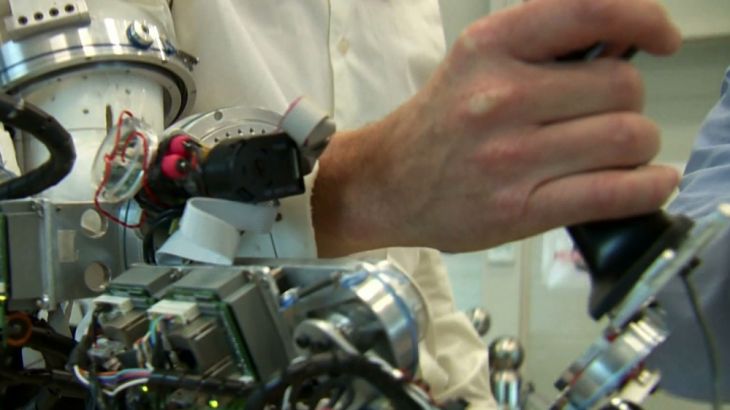First handshake between space and Earth
Researchers have demonstrated new advanced robotics that allow real-time remote control between Earth and space.

For the first time scientists working at the European Space Agency (ESA) have demonstrated new advanced robotics which allowed a researcher in the Netherlands to “shake the hand” of an astronaut orbiting 400km above the Earth.
The team developed a communications system and control technology to connect two joysitcks; one in their lab at the European Space and Technology Research Centre in the Netherlands, the other on board the International Space Station.
Keep reading
list of 4 itemsBoeing postpones launch of Starliner space capsule after technical fault
China launches Chang’e-6 probe to study dark side of the moon
China launches historic mission to far side of the moon
“We controlled the joystick here on ground with force feedback,” said Andre Schiele, telerobotics specialist at the ESA.
“We shook hands with Terry Virts, a NASA astronaut, we felt his force feedback on the hand and showed that it is possible to literally reach down to ground and touch things on the surface.”
The signal from the International Space Station had to travel to another satellite some 36,000km above Earth, then through Houston mission control in USA and across the Atlantic Ocean to the Netherlands, all in 0.4 seconds.
The team are also working on robotic exoskeleton into which an opperator slides their arm. The robot then mimics every movement and provides physical feedback to the opperator.
Historic first handshake between #space and #Earth: http://t.co/o9PcuPaDN6 pic.twitter.com/O57wp9PB95
— ESA Operations (@esaoperations) June 3, 2015
The team say this will make the technology much more user-friendly.
“Astronauts have plenty of tasks to execute and part of it is also controlling robots,” Joao Rebelo, ESA researcher, told Al Jazeera.
“This requires many months, even years of training. The idea here is that by having a more intuitive interface you can reduce this training time, not only for astronauts but in the future for other operators to execute different types of activities.”
The researchers say the technology give an opperator direct and sensitive feedback, which could help when it comes to using robots to do delicate work in the extreme conditions found in offshore drilling or nuclear reactors.
In space they say the technology could also allow astronauts in orbit around the moon or a planet like Mars to perform work on the surface without having to endure the planet’s harsh atmosphere.
“You could have a robot on the ground and have an astronaut orbiting a planet using this robot on the ground to build a base before landing,” says Rebelo.
“On the Space Station it is very dangerous for an astronuat to go outside and do certain tasks, so it would be better to have a robot outside and have an astronaut inside executing this task using the robot.”
The team is planning to test a more advanced robot in September.